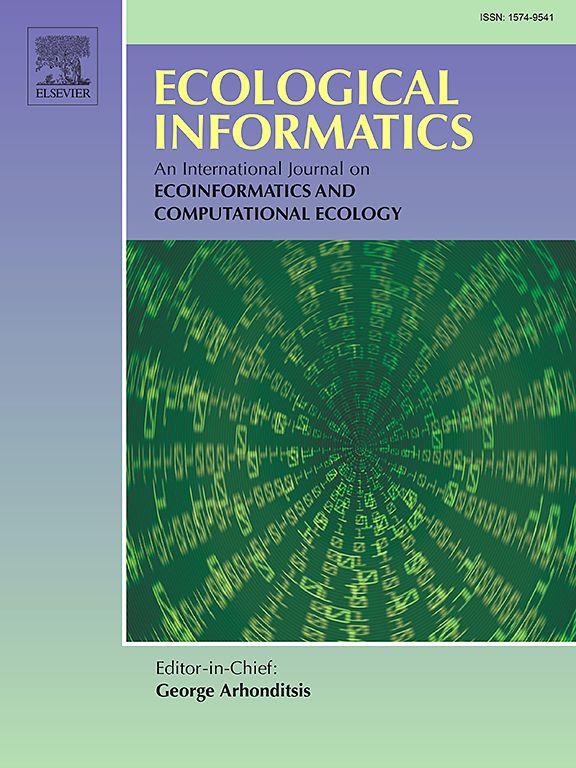Sampling effort for community composition higher by a magnitude compared to species richness in passive acoustic monitoring
IF 5.8
2区 环境科学与生态学
Q1 ECOLOGY
引用次数: 0
Abstract
1. Comprehensive estimations of relative abundances and changes therein are one of the most important measures of conservation monitoring. The use of passive acoustic monitoring (PAM) has the potential to greatly enhance information availability, yet has mainly focused on species diversity or coverage, yielding results comparable to those from expert observers. Comparisons with conventional monitoring data have been made mainly for point counts, even though area-wide territory mapping is a widely used standard in many monitoring programs.
2. We compare data derived from the combination of PAM and automated identification via machine learning with an area-wide conventional breeding bird survey conducted by expert observers across the Marburg Open Forest in Hesse, Germany. By varying the number of survey intervals, recording duration and locations, we then determined the sampling effort needed to adequately reflect both species coverage and community composition of the conventional survey.
3. Only small subsamples of PAM data were required to reach maximum species richness of the conventional survey; minimum requirements were as low as 1) one survey interval or 2) 30 min duration or 3) three recording locations if other factors were allowed to vary accordingly. Revealing the community composition of the conventional survey, however, required sampling over three to six survey intervals with recording durations between 10 and 100 h. While communities were similar between methods in terms of species activity and relative abundance, PAM also partially reflected the composition of territories in the conventional survey.
4. Our study demonstrates the relative importance of greater sampling effort especially for monitoring community composition, requiring more recording locations, duration and intervals in comparison to species richness. We provide insight into the current applicability of PAM in monitoring practice and present best-use scenarios on how to make the most of high spatio-temporal resolution acoustic monitoring data.
在被动声学监测中,群落组成的采样努力比物种丰富度高一个数量级
1. 相对丰度及其变化的综合估算是保护监测的重要手段之一。被动声监测(PAM)的使用有可能大大提高信息的可用性,但主要集中在物种多样性或覆盖范围上,产生的结果与专家观察员的结果相当。与传统监测数据的比较主要是点数,尽管在许多监测方案中广泛使用的是区域范围内的测绘标准。我们将PAM和机器学习自动识别相结合的数据与德国黑森州马尔堡开放森林的专家观察员进行的全区域常规繁殖鸟类调查进行了比较。通过改变调查间隔的次数、记录时间和地点,我们确定了充分反映常规调查的物种覆盖率和群落组成所需的采样努力。只需要PAM数据的小样本就可以达到常规调查的最大物种丰富度;最低要求低至1)一次调查间隔或2)30分钟持续时间或3)三个记录位置,如果允许其他因素相应地变化。然而,揭示传统调查的群落组成需要在3到6个调查间隔内采样,记录时间在10到100小时之间。尽管不同方法的群落在物种活动和相对丰度方面相似,但PAM也部分反映了传统调查中领土的组成。我们的研究表明,与物种丰富度相比,更大的采样努力对于监测群落组成的重要性,需要更多的记录位置、持续时间和间隔。我们提供了PAM目前在监测实践中的适用性的见解,并提出了如何充分利用高时空分辨率声学监测数据的最佳使用场景。
本文章由计算机程序翻译,如有差异,请以英文原文为准。
求助全文
约1分钟内获得全文
求助全文
来源期刊

Ecological Informatics
环境科学-生态学
CiteScore
8.30
自引率
11.80%
发文量
346
审稿时长
46 days
期刊介绍:
The journal Ecological Informatics is devoted to the publication of high quality, peer-reviewed articles on all aspects of computational ecology, data science and biogeography. The scope of the journal takes into account the data-intensive nature of ecology, the growing capacity of information technology to access, harness and leverage complex data as well as the critical need for informing sustainable management in view of global environmental and climate change.
The nature of the journal is interdisciplinary at the crossover between ecology and informatics. It focuses on novel concepts and techniques for image- and genome-based monitoring and interpretation, sensor- and multimedia-based data acquisition, internet-based data archiving and sharing, data assimilation, modelling and prediction of ecological data.
 求助内容:
求助内容: 应助结果提醒方式:
应助结果提醒方式:


